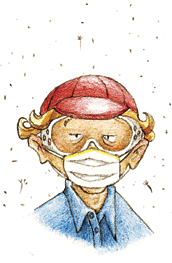A Common Connection:
Allergies, Colds, Asthma
Richard T. Crane, MD, FACS
Western Wisconsin Ear, Nose & Throat Center, Eau Claire
Runny nose, congestion, sneezing, or an itchy throat can all be warm weather symptoms of seasonal nasal allergy or allergic rhinitis. Because allergy symptoms occur at the same time every year, many people confuse seasonal allergic rhinitis with their “usual” spring or summer cold. This is understandable because many of the symptoms are similar, and are caused by inflammation of the mucous membranes in the nose and throat. However, there are some ways to tell the difference between a cold and seasonal allergy.
A cold often begins with a sore throat, may include a fever, coughing, a general “ache all over” feeling, and usually lasts for 7 – 10 days. With a cold, the nasal mucus will start out thin and clear, but will become thicker after a few days. By contrast, seasonal allergic rhinitis is more likely to produce itching in the nose or throat and sneezing. Seasonal allergy symptoms will often drag on for weeks and months if not treated. Unless secondary infection occurs, allergic nasal mucus will continue to be thin, clear and watery.
Some unfortunate people have year-round allergies. These people will feel like they always have a cold. Because colds are common, it is not unusual to catch a cold on top of one’s allergy symptoms; children and young adults average 4-5 colds per year, older adults only 2 or 3.
Infection of the upper respiratory tract by a virus produces inflammation and symptoms that we refer to as the “common cold”. Sometimes a cold virus will work its way down into the larynx and bronchial tubes. When this happens, we experience hoarseness, coughing and sometimes wheezing or trouble breathing. Many call this a “chest cold”. The symptoms of a chest cold, or viral bronchitis, are very similar to those of an asthma attack. In fact, treatment of the viral bronchitis is the same as treatment for an acute asthmatic episode. The main difference between acute viral bronchitis and asthma is that asthma is a chronic inflammatory condition of the lungs and bronchial tubes.
What causes the chronic inflammation in asthmatics?
It has been discovered within the last decade that the cause in almost all cases is allergies. Modern guidelines for management of asthma now recommend evaluation for allergy and some form of appropriate anti-inflammatory treatment.
When the immune system mistakenly tries to protect us from an allergen, inflammation is produced. This inflammation leads to the symptoms we associate with allergies. Allergens that cause allergic rhinitis and asthma are microscopic airborne particles composed of proteins such as pollens, mold spores, animal dander and dust mites.
There are three ways of treating allergic rhinitis or asthma:
- Environmental control to limit exposure to allergens
- Medication to prevent or relieve symptoms
- Immunotherapy to reduce the body’s immune system reaction to allergens
Environmental control, or avoidance therapy, is based on the principle that a person will not develop symptoms if they are not exposed to allergens to which they are sensitive. It is helpful to think in terms of “outdoor allergens” (pollens and many mold spores) and “indoor allergens” (dust, mites, some mold spores and pet dander) when applying avoidance therapy.
Keeping outdoor allergens outdoors can be achieved by:
- Using air conditioning so that windows and doors can be kept closed
- Drying clothes and bedding in a dryer instead of outdoors on a line
- Putting outdoor play or work clothes in the laundry and taking a shower soon after entering the house
Efforts to reduce indoor allergens should focus on the bedroom. Methods to consider include:
- Keeping pets out of the bedroom
- Dust and mite barrier fabric casings for pillows and mattresses
- Reducing moisture and humidity to discourage mold and mite growth
- Eliminating dust collecting items such as bed ruffles, draperies, floor rugs, stuffed animals
- Air filters and frequent vacuuming
Medication treatment for allergies and asthma aims to prevent reactive inflammation and reduce symptoms.
Saline nasal sprays can be used to reduce symptoms by minimizing the time allergens are in contact with nasal membranes. Antihistamines relieve itching, runny nose and sneezing by blocking the action of histamine, one of the inflammatory compounds. Recently developed anti-leukotriene drugs can block another group of compounds, leukotrienes. A topically applied drug, cromolyn, can be used as a nasal spray or sometimes inhaled into the lungs to stop the release of inflammatory compounds. Decongestants are often taken to reduce the congestion of a stuffy nose. Bronchodilator drugs are used in asthma treatment to relax the muscles that cause constriction of the bronchial tubes.
Corticosteroids (not the kind of "steroids" that get you
kicked off of the football team) are a powerful class of anti-inflammatory
drugs. Steroids that are swallowed or injected (systemic steroids) may
cause significant side effects. They are sometimes necessary for a severe
asthma attack, but are rarely used for allergic rhinitis. Topically
applied steroids show very little absorption into the body and are safe
and effective for relieving symptoms of nasal allergy and reducing the
destructive lung inflammation in asthma.
Immunotherapy (IT), or “allergy shots”, is the third way of treating allergies and asthma, because IT reduces the body’s response to allergen exposure. IT treatment is recommended only after allergy has been confirmed through testing. It is the treatment that comes closest to actual elimination of a person’s allergies or asthma. Immunotherapy is most commonly given by injections just under the skin.
The goals of immunotherapy are to reduce or eliminate allergy and asthma symptoms, reduce inflammation and to reduce the need for medications.
So, if you seem to get that “cold” at about the same time every year, your symptoms occur frequently, or if symptoms just seem to linger on, you may want to seek your doctor’s help in determining if the problem is a cold, or if it is allergies.
For more information, call Dr. Richard Crane, Western Wisconsin
Ear, Nose & Throat Center, Eau Claire » 715.831.0289





